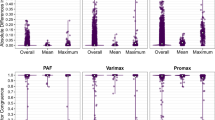Abstract
The oblimax, promax, maxplane, and Harris-Kaiser techniques are compared. For five data sets, of varying reliability and factorial complexity, each having a graphic oblique solution (used as criterion), solutions obtained using the four methods are evaluated on (1) hyperplane-counts, (2) agreement of obtained with graphic within-method primary factor correlations and angular separations, (3) angular separations between obtained and corresponding graphic primary axes. The methods are discussed and ranked (descending order): Harris-Kaiser, promax, oblimax, maxplane. The Harris-Kaiser procedure—independent cluster version for factorially simple data,P'P proportional to φ, with equamax rotations, for complex—is recommended.
Similar content being viewed by others
References
Baehr, M. E. A comparison of graphic and analytic solutions for both oblique and orthogonal simple structures for factors of employee morale.Psychometrika, 1963,28, 199–209.
Bargmann, R. The statistical significance of simple structure in factor analysis. Frankfurt-Main: Hochschule fuer Internationale Paedagogische Forschung, 1953. Cited by R. B. Cattell, The meaning and strategic use of factor analysis. In R. B. Cattell (Ed.),Handbook of multivariate experimental psychology. Chicago: Rand-McNally, 1966.
Burt, C. The factorial study of temperamental traits.British Journal of Psychology, Statistical Section, 1948,1, 178–203.
Butler, J. M. Simplest data factors and simple structure in factor analysis.Educational and Psychological Measurement, 1964,24, 755–763.
Carroll, J. B. An analytical solution for approximating simple structure in factor analysis.Psychometrika, 1953,18, 23–38.
Carroll, J. B. Biquartimin criterion for rotation to oblique simple structure in factor analysis.Science, 1957,126, 1114–1115.
Cattell, R. B., & Baggaley, A. R. The salient variable similarity index for factor matching.British Journal of Statistical Psychology, 1960,13, 33–46.
Cattell, R. B., Balcar, K. R., Horn, J. L., & Nesselroade, J. R. Factor matching procedures: An improvement of thes index; with tables.Educational and Psychological Measurement, 1969,29, 781–792.
Cattell, R. B., & Dickman, K. W. A dynamic model of physical influences demonstrating the necessity of oblique simple structure.Psychological Bulletin, 1962,59, 389–400.
Cattell, R. B., & Muerle, J. L. The “maxplane” program for factor rotation to oblique simple structure.Educational and Psychological Measurement, 1960,20, 569–590.
Coan, R. W. A comparison of oblique and orthogonal factor solutions.Journal of Experimental Education, 1959,27, 151–166.
Eber, H. W. Toward oblique simple structure: Maxplane.Multivariate Behavioral Research, 1966,1, 112–125.
Eyman, R. K., Dingman, H. F., & Meyers, C. E. Comparison of some computer techniques for factor analytic rotation.Educational and Psychological Measurement, 1962,22, 201–214.
Fruchter, B., & Novak, E. A comparative study of three methods of rotation.Psychometrika, 1958,23, 211–221.
Gorsuch, R. L. A comparison of biquartimin, maxplane, promax, and varimax. Unpublished manuscript, Vanderbilt University, 1968.
Hakstian, A. R.Methods of oblique factor transformation. (Doctoral dissertation, University of Colorado) Ann Arbor, Michigan: University Microfilms, 1969. No. 70-5851.
Harman, H. H.Modern factor analysis. Chicago: University of Chicago Press, 1960.
Harman, H. H.Modern factor analysis. (2nd ed.) Chicago: University of Chicago Press, 1967.
Harris, C. W., & Kaiser, H. F. Oblique factor analytic solutions by orthogonal transformations.Psychometrika, 1964,29, 347–362.
Hendrickson, A. E., & White, P. O. PROMAX: A quick method for rotation to oblique simple structure.British Journal of Statistical Psychology, 1964,17, 65–70.
Horn, J. L. Second-order factors in questionnaire data.Educational and Psychological Measurement, 1963,23, 117–134.
Jennrich, R. I., & Sampson, P. F. Rotation for simple loadings.Psychometrika, 1966,31, 313–323.
Kaiser, H. F. The varimax criterion for analytic rotation in factor analysis.Psychometrika, 1958,23, 187–200.
Kaiser, H. F. Varimax solution for Primary Mental Abilities.Psychometrika, 1960,25, 153–158.
Kashiwagi, S. Geometric vector orthogonal rotation method in multiple-factor analysis.Psychometrika, 1965,30, 515–530.
Mosier, C. I. Determining a simple structure when loadings for certain tests are known.Psychometrika, 1939,4, 149–162.
Neuhaus, J. O., & Wrigley, C. The quartimax method: An analytic approach to orthogonal simple structure.British Journal of Statistical Psychology, 1954,7, 81–91.
Pinneau, S. R., & Newhouse, A. Measures of invariance and comparability in factor analysis for fixed variables.Psychometrika, 1964,29, 271–281.
Rimoldi, H. J. A. Study of some factors related to intelligence.Psychometrika, 1948,13, 27–46.
Saunders, D. R. The rationale for an “oblimax” method of transformation in factor analysis.Psychometrika, 1961,26, 317–324.
Schönemann, P. H. Varisim: A new machine method for orthogonal rotation.Psychometrika, 1966,31, 235–248.
Sokal, R. R. Thurstone's analytical method for simple structure and a mass modification thereof.Psychometrika, 1958,23, 237–257.
Tenopyr, M. L., & Michael, W. B. A comparison of two computer-based procedures of orthogonal analytic rotation with a graphical method when a general factor is present.Educational and Psychological Measurement, 1963,23, 587–597.
Thurstone, L. L.Multiple-factor analysis. Chicago: University of Chicago Press, 1947.
Tucker, L. R. A method for synthesis of factor analysis studies. Personnel Research Section Report, No. 984. Washington, D. C.: Department of the Army, 1951. Cited by H. H. Harman,Modern factor analysis. (2nd ed.) Chicago: University of Chicago Press, 1967.
Wrigley, C., & Neuhaus, J. O. The matching of two sets of factors. Contract Report, No. A-32, Task A. Urbana, Illinois: University of Illinois, 1955. Cited by H. H. Harman,Modern factor analysis. (2nd ed.) Chicago: University of Chicago Press, 1967.
Wrigley, C., Saunders, D. R., & Neuhaus, J. O. Application of the quartimax method of rotation to Thurstone's Primary Mental Abilities study.Psychometrika, 1958,23, 151–170.
Author information
Authors and Affiliations
Additional information
This paper is based upon part of the author's doctoral dissertation [Hakstian, 1969] completed at the University of Colorado. The author is greatly indebted to Dr. Gene V Glass, who, as thesis advisor, generously contributed his time, erudition, and encouragement.
Rights and permissions
About this article
Cite this article
Ralph Hakstian, A. A comparative evaluation of several prominent methods of oblique factor transformation. Psychometrika 36, 175–193 (1971). https://doi.org/10.1007/BF02291397
Received:
Revised:
Issue Date:
DOI: https://doi.org/10.1007/BF02291397




